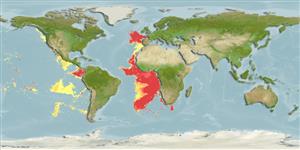>
Lophiiformes (Anglerfishes) >
Linophrynidae (Leftvents)
Etymology: Linophryne: Greek, 'linon' = flax or anything made of flax such as "cord," "rope," or a "net" + Greek, 'phryne' = "toad" (refers to a toadlike fish that fishes with a net) (Ref. 86949).
More on author: Beebe.
Environment: milieu / climate zone / depth range / distribution range
Οικολογία
Θαλασσινό(ά) βαθυπελαγικό(ς); εύρος βάθους 650 - 1900 m (Ref. 86949). Deep-water
Eastern Atlantic: south of Madeira. Eastern Pacific: Gulf of Panama and Coco Is., Costa Rica.
Μέγεθος / Βάρος / Age
Maturity: Lm ? range ? - ? cm
Max length : 5.1 cm (female)
Short description
Μορφολογία | Μορφομετρία
Μαλακές ραχιαίες ακτίνες (συνολικά): 3; Μαλακές εδρικές ακτίνες: 3. Metamorphosed females distinguished by the following characteristics: escal bulb with compressed, flange-shaped anterior appendage; stout, cylindrical distal escal appendage with terminal filament; base of distal escal appendage with pair of structures on posterior margin, each consisting of a hemispherical protuberance with digitiform anterior prolongation; posterior escal appendage compressed; barbel 118-357% SL, with several short, unpigmented distal branches bearing sessile and stalked photophores; stem of barbel pigmented with or without short simple lateral branches, each with distal photophore (Ref. 86949).
Also mesopelagic (Ref. 10762).
Life cycle and mating behavior
Γεννητική Ωρίμανση | Αναπαραγωγή | Γεννοβολία | Αβγά | Γονιμότητα | Προνύμφες
Bertelsen, E., 1990. Linophrynidae. p. 516-519. In J. C. Quero, J. C. Hureau, C. Karrer, A. Post and L. Saldanha (eds.) Check-list of the fishes of the eastern tropical Atlantic (CLOFETA). JNICT, Lisbon; SEI, Paris; and UNESCO, Paris. Vol. 1. (Ref. 10762)
IUCN Red List Status (Ref. 130435)
Threat to humans
Harmless
Human uses
Περισσότερες πληροφορίες
Κοινά ονόματαΣυνώνυμαΜεταβολισμόςΘηρευτέςΟικοτοξικολογίαΑναπαραγωγήΓεννητική ΩρίμανσηΓεννοβολίαΣυναθροίσεις γεννοβολίαςΓονιμότηταΑβγάEgg development
Age/SizeΑύξησηLength-weightLength-lengthLength-frequenciesΜορφομετρίαΜορφολογίαΠρονύμφεςΔυναμική προνυμφώνΣτρατολόγησηΑφθονίαBRUVS
ΑναφορέςΥδατοκαλλιέργειεςΠροφίλ υδατοκαλλιέργειαςΣτελέχοιΓενετικήElectrophoresesΚληρονομικότηταΑσθένειεςΜεταποίησηNutrientsMass conversion
ΣυνεργάτεςΦωτογραφίεςStamps, Coins Misc.ΉχοιΣιγκουατέραΤαχύτηταΚολυμβητικός ΤύποςΕπιφάνεια βραγχίωνOtolithsΕγκέφαλοιΌραση
Εργαλεία
Special reports
Download XML
Διαδικτυακές πηγές
Estimates based on models
Preferred temperature (Ref.
123201): 2.1 - 2.6, mean 2.6 °C (based on 61 cells).
Phylogenetic diversity index (Ref.
82804): PD
50 = 0.5000 [Uniqueness, from 0.5 = low to 2.0 = high].
Bayesian length-weight: a=0.01995 (0.00906 - 0.04395), b=3.01 (2.83 - 3.19), in cm total length, based on all LWR estimates for this body shape (Ref.
93245).
Τροφικό Επίπεδο (Ref.
69278): 3.7 ±0.6 se; based on size and trophs of closest relatives
Fishing Vulnerability (Ref.
59153): Low vulnerability (10 of 100).
